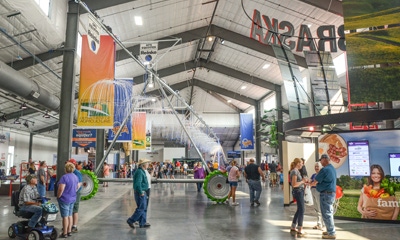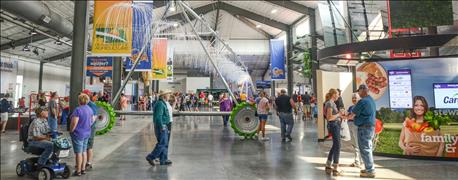
Visitors at the 2016 Nebraska State Fair will notice a few new features at the Raising Nebraska exhibit, an exhibit which allows fairgoers to immerse themselves in agriculture — from operating a simulated combine to controlling individual sprinkler heads through a variable-rate-irrigation simulator.

FOCUS ON SOIL: The Raising Nebraska building at the Nebraska State Fair will include some new features this year, including a new focus on soil health in the "Living Soil" exhibit.
Last year saw the addition of several new features — including a Raising Nebraska Outdoors exhibit, featuring a pivot span donated from Reinke and a walkable map of Nebraska with different crops and plants grown in different parts of the state. Visitors also saw new livestock and meat product exhibits, including grocery-store-cooler displays with videos showing how different products — beef, pork, milk and eggs — end up at the grocery store from their start on the farm.
This year, Raising Nebraska will offer a new "Living Soil" exhibit, where visitors can learn about the important role soil plays, not just in agriculture but in urban and residential areas, too, says Beth Janning, the University of Nebraska Extension educator who manages the exhibit year-round.
Living Soil features different displays and exhibits that focus on soil health and the role it plays in agriculture, including an interactive nutrient game. "The game highlights different nutrients and nutrient cycles in different ecosystems," Janning says. "There are three different game scenarios, with questions focused on livestock manure, crops — and the last is focused on residential landscapes or lawns."
Another focus of the Living Soil exhibit is soil structure and soil type. One display will have simulated soils to let visitors feel the texture of different soil types — whether clay, sand, loam or silt. The exhibit will also have core soil samples collected from across the state to demonstrate the different soil types found in Nebraska. "We talk about the different elevation and soil types in Nebraska that are conducive to different kinds of agriculture across the state, but what does that actually mean?" Janning says.
In previous years, Trusted Voices kiosks have been dedicated to informing visitors about topics like irrigation and water use, weed control and animal welfare. This year, a new Trusted Voices kiosk will be dedicated to soil and the role it plays in Nebraska agriculture.
In addition, the exhibit will also have a display focused on the role roots play in soil health. "The idea is to show that you may have a little bit of biomass on top, but roots go down a long way into the ground — and understanding how different root patterns play a part in the soil," Janning says.
Another new exhibit this year will be a new interactive quiz-based game, allowing up to four players to answer different questions pertaining to agricultural careers and food.
Meanwhile, the Raising Nebraska Outdoors exhibit, which was new last year, will feature new crops and plants. "This year we have sugarbeets, sunflowers, chicory, potatoes, as well as pumpkins and vine plants," Janning says. "Our trees have been established for a year now; some of the fruit trees will actually have fruit on them this year. There is a lot of progress that's been made at the outdoor exhibit, and we're excited to be able to show that off."
About the Author(s)
You May Also Like






